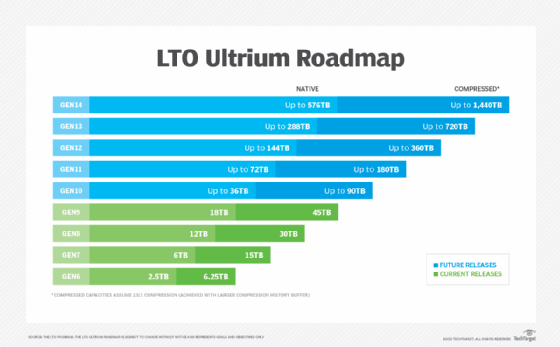LTO-9 (Linear Tape-Open 9)
What is LTO-9 (Linear Tape-Open 9)?
LTO-9 is a tape format from the Linear Tape-Open (LTO) Consortium. It launched in 2021.
LTO Ultrium, often used for backup and archiving, is the standard form factor of the LTO cartridge developed and released by the consortium. LTO-9 provides 18 terabytes of native capacity and 45 TB compressed.
Linear Tape-Open is an open tape format developed and amended by LTO Consortium members HPE, IBM and Quantum. According to a 2023 report from HPE, IBM and Quantum, approximately 148.3 exabytes of compressed tape capacity shipped in 2022. This was an increase of 0.5% over 2021.
Uses for LTO-9
While tape has largely given way to other media, such as disk, for primary storage purposes, it still presents a valuable backup and archiving opportunity. LTO features high capacity, durability and portability for a comparatively low cost.
Archived data -- commonly used for compliance purposes and retaining records -- is not typically needed immediately, so tape is a strong option. Backup data is used for restores in the event of an incident.
Off-site LTO-9 tapes are an option for disaster recovery. If a primary data center goes down, the organization can use those tapes to recover data.
While disk can help with fast backups and restores, once data becomes less frequently accessed, organizations often move it to tape for inexpensive, secure long-term storage. Tape is especially useful for industries such as science and entertainment that create large volumes of data daily and need long-term data storage that's cheaper than disk.
As cyberattacks such as ransomware remain prevalent, tape provides an offline backup storage option. Data on an LTO-9 cartridge that's not connected to an organization's network is safe from a cyberattack.
An LTO-9 tape can also help with data transfers. It can take far less time to migrate terabytes of data to the cloud or a remote data center using a shipped tape rather than streaming the data over a network.
History of LTO tape
LTO is a tape storage technology created by Hewlett Packard, now HPE; IBM; and Seagate Technology. The companies began working together on the tape project in 1997. Quantum replaced Seagate in 2005 after buying Certance, which was a division of Seagate that manufactured tape drives.
LTO technology first launched in 2000. Since the release of LTO-1, a new version has typically come out every two to three years, generally doubling the capacity of the previous generation. The technology has had several advancements over the years, including the write once, read many (WORM) feature, encryption and the Linear Tape File System (LTFS).
LTO-1 provided native capacity of up to 100 gigabytes and compressed capacity of up to 200 GB. The native data transfer rate was as high as 20 megabytes per second, and the compressed rate was as high as 40 MBps.
LTO-2, released in 2003, provided a maximum native capacity of 200 GB and a maximum compressed capacity of 400 GB. The native data transfer rate was up to 40 MBps, and the compressed transfer rate was up to 80 MBps.
LTO-3, launched in 2004, provided a maximum native capacity of 400 GB and a maximum compressed capacity of 800 GB. The maximum native data transfer rate was 80 MBps, and the maximum compressed rate was 160 MBps. LTO-3 added the WORM feature.
LTO-4, which came out in 2007, provided a native storage capacity of up to 800 GB and compressed capacity of up to 1.6 TB. The native data transfer rate was up to 120 MBps, and the compressed transfer rate was up to 240 MBps. LTO-4 added data encryption.
LTO-5, available starting in 2010, provided a maximum native storage capacity of 1.5 TB and a maximum compressed capacity of 3 TB. The maximum native data transfer rate was 140 MBps, and the maximum compressed transfer rate was 280 MBps. LTO-5 added partitioning through LTFS.
LTO-6, released in 2012, provided a maximum native storage capacity of 2.5 TB and a maximum compressed capacity of 6.25 TB. The maximum native data transfer rate was 160 MBps, and the compressed rate was up to 400 MBps. With LTO-6, the compression ratio for capacity jumped from 2:1 to 2.5:1.
LTO-7, launched in 2015, provided a maximum native storage capacity of 6 TB and a maximum compressed capacity of 15 TB. The maximum native data transfer rate was 300 MBps, and the compressed rate was up to 700 MBps.
LTO-8 launched in 2017. It provides 30 TB of compressed storage capacity and 12 TB of uncompressed capacity, doubling what LTO-7 offered.
As of April 2024, LTO-9 is the current generation. According to the LTO Ultrium roadmap, LTO-10 is due to be launched in 2024. The new version is expected to provide 36 TB of native capacity and 90 TB compressed.
Important features
The WORM feature, added with LTO-3, enables organizations to only write once to the tape -- ensuring data is not overwritten, altered or erased -- and helps satisfy compliance and regulatory requirements. WORM also reduces the risk of data loss from human error.
Data encryption, starting with LTO-4, improves security. The 256-bit Advanced Encryption Standard with the Galois/Counter Mode algorithm executed at the tape drive level facilitates compression before encryption.
The LTFS partitioning feature, beginning with LTO-5, improves file control and space management. Through its indexing capability, partitioning tells the drive where a file is stored on the tape.
Pros and cons
Tape capacity continues to grow. When LTO-9 launched, it increased the compressed capacity of the LTO product by close to 60 TB in approximately 10 years. As data volume continues to grow exponentially for many organizations, capacity is an important element of data storage media. Compared with storing 60 TB on other storage media such as disk or flash, the cost of tape is low, especially when taking energy and equipment into consideration. Electricity is not required to preserve data stored on tape.
Other advantages of LTO include the following:
- A reliable product roadmap that allows customers to count on a new generation every couple of years, and a capacity that is very close to the original estimate.
- Encryption that ensures security during storage and shipment. Tape's offline nature serves as protection from ransomware and other cyberattacks.
- Reliability, with a durability of generally 30 years. The tape format is also portable, so organizations can ship it easily.
LTO's open format also enables customers to access multiple, compatible products. The open format offers intellectual property licenses to potential manufacturers, which can lead to faster innovation and more improvements. LTO products, though, are not compatible with non-LTO products.
While disk is generally more expensive than tape, it provides quicker and easier restoration and thus can be a better backup option. In addition, tape is linear, so it does not provide random access like disk.
The cloud is increasingly more of a backup preference, especially for small and medium-sized businesses. Depending on volume, cloud storage can be cheaper than tape. Some cloud backup providers even offer a free option up to a certain amount of data. Unlike tape, the cloud provides random access, but restoration can be slow depending on data volume and bandwidth.
LTO-9 vs. LTO-8
LTO-8 features an uncompressed data transfer rate of up to 360 MBps and a compressed data transfer rate of up to 750 MBps. The native data transfer rate of LTO-9 is up to 400 MBps, and the compressed rate is 1,000 MBps.
LTO had typically been able to read back two generations and write back one generation. However, with LTO-8, the inclusion of tunnel magnetoresistance technology and barium ferrite limits that backward reading compatibility to one generation. TMR, a switch from giant magnetoresistance, increases density in the tape head. Barium ferrite improves capacity.
LTO-8 tape drives are backward compatible with one generation, so they can read and write to LTO-7 tapes. LTO-9 has the same structure and is fully backward compatible with LTO-8.
LTO-8 and LTO-9 feature WORM, LTFS and encryption.
Future LTO specifications
The LTO roadmap runs out to the 14th generation, with LTO-10, LTO-11, LTO-12, LTO-13 and LTO-14 all projected to feature WORM, LTFS and encryption.
- LTO-10 is slated to offer 36 TB of uncompressed capacity and 90 TB compressed.
- LTO-11 is projected to provide 72 TB of uncompressed capacity and 180 TB compressed.
- LTO-12 is expected to feature 144 TB of uncompressed capacity and 360 TB compressed.
- LTO-13 is expected to feature 288 TB of uncompressed capacity and 720 TB compressed.
- LTO-14 is expected to feature 576 TB of uncompressed capacity and 1,440 TB compressed.

In the past, because the capacity increase was not high enough to spur a switch to the new version, users would often skip an LTO generation before upgrading. For example, moving from LTO-4 to LTO-5 increased the uncompressed capacity by less than 1 TB. Now, each new LTO generation has a large enough capacity increase to warrant an immediate upgrade. For example, jumping from LTO-8 to LTO-9 offers an uncompressed capacity increase of 6 TB per cartridge.
In addition, the ability of an LTO tape drive to only read back one generation will encourage organizations to upgrade faster.






